
Marrubium is a genus of flowering plants in the family Lamiaceae, native to temperate regions of Europe, North Africa, and Asia as far east as the Xinjiang region of western China. A few species are also naturalized in North and South America.

Avena is a genus of Eurasian and African plants in the grass family. Collectively known as the oats, they include some species which have been cultivated for thousands of years as a food source for humans and livestock. They are widespread throughout Europe, Asia and northwest Africa. Several species have become naturalized in many parts of the world, and are regarded as invasive weeds where they compete with crop production. All oats have edible seeds, though they are small and hard to harvest in most species.

Alopecurus, or foxtail grass, is a common and widespread genus of plants in the grass family. It is common across temperate and subtropical parts of Eurasia, northern Africa, and the Americas, as well as naturalized in Australia and on various islands.

Scorzonera is a genus of flowering plants in the tribe Cichorieae within the family Asteraceae.

Agropyron is a genus of Eurasian plants in the grass family), native to Europe and Asia but widely naturalized in North America.

Petrorhagia is a small genus of annual and perennial plants of the family Caryophyllaceae, mostly native to the Mediterranean region. It is low-growing with wiry stems and narrow, grass-like leaves. The flowers are small, in clusters similar to members of the genus Dianthus, in pink, lilac, or white. Petrorhagia saxifraga is the tunic flower or coat flower, similar to baby's breath, but shorter, and used in rock gardens.

Ballota (horehound) is a genus of flowering evergreen perennial plants and subshrubs in the family Lamiaceae. native to temperate regions. The Mediterranean region has the highest diversity in the genus, with more isolated locations in South Africa, Central Asia, northern Europe, and the islands of the eastern North Atlantic. It is found in rocky and waste ground.
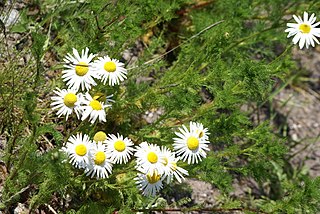
Tripleurospermum is a genus in the chamomile tribe within the sunflower family. Mayweed is a common name for plants in this genus.

Koeleria is a common and widespread genus of plants in the grass family, found on all continents except Antarctica and on various oceanic islands. It includes species known generally as Junegrasses.
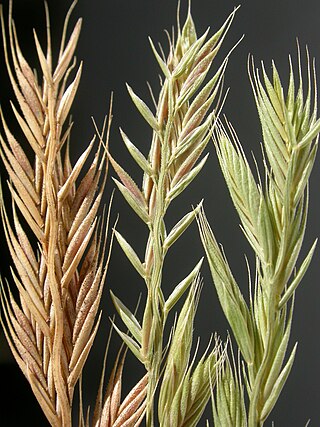
Vulpia is a widespread genus of plants in the grass family, native to many countries around the world and naturalized in many of the nations to which it is not native. It is most common in temperate regions.

Apera is a small genus of annual grasses, known commonly as silkybent grass or windgrass. They are native to Europe, North Africa and parts of Asia but have been introduced and naturalized in much of North and South America.
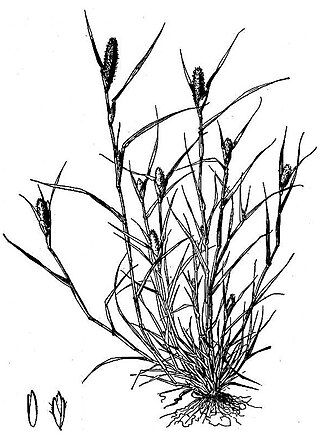
Crypsis is a genus of African and Eurasian plants in the grass family, sometimes referred to as pricklegrass. These are annual grasses with short leaves. A few species are invasive weeds outside their native ranges.

Rostraria is a genus of plants in the grass family, native primarily to Eurasia and North Africa with one species native to South America. Hairgrass is a common name.
Zingeria is a genus of Asian and European plants in the grass family. Their native range covers the Black Sea and eastern Mediterranean regions from Romania to Kazakhstan.

Gaudinia is a genus of Mediterranean plants in the grass family.

Ventenata dubia is a species of grass known by the common names North Africa grass and wiregrass. It is native to southern Europe, North Africa and the Middle East. It is becoming well known in North America, where it is an introduced species and a noxious weed of cultivated and disturbed habitat. It is problematic in the Pacific Northwest, where it was first identified in Washington in 1952 and Idaho in 1957. It was found in Utah in 1996. It probably spreads when it gets mixed in with grass seed and is transported and inadvertently planted.

Cota is a genus belonging to the chamomile tribe within the sunflower family. It is native to Europe, North Africa, and southwestern Asia, with a few species naturalized elsewhere. It is an herbaceous plant with flower heads including white or yellow ray florets and yellow disc florets.
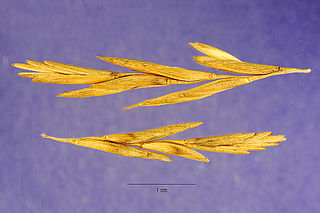
Thinopyrum is a genus of Eurasian and African plants in the grass family.

Anthemis cretica, the Cretian mat daisy or white mat chamomile, is a species of flowering plant in the family Asteraceae. It or its many subspecies can be found around the Mediterranean region, the Black Sea area, Poland, the Caucasus, and the Middle East as far as Iran. It is highly morphologically variable, and the namesake of a species complex.
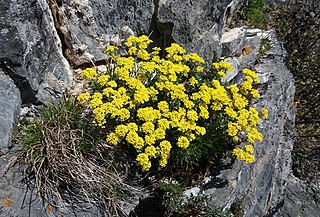
Odontarrhena is a large genus of flowering plants in the family Brassicaceae. They were originally a separate genus and then were amalgamated into the Alyssum genus, but then morphological and molecular evidence has reseperated them. Some of the genera are nickel (Ni) hyperaccumulators.



















